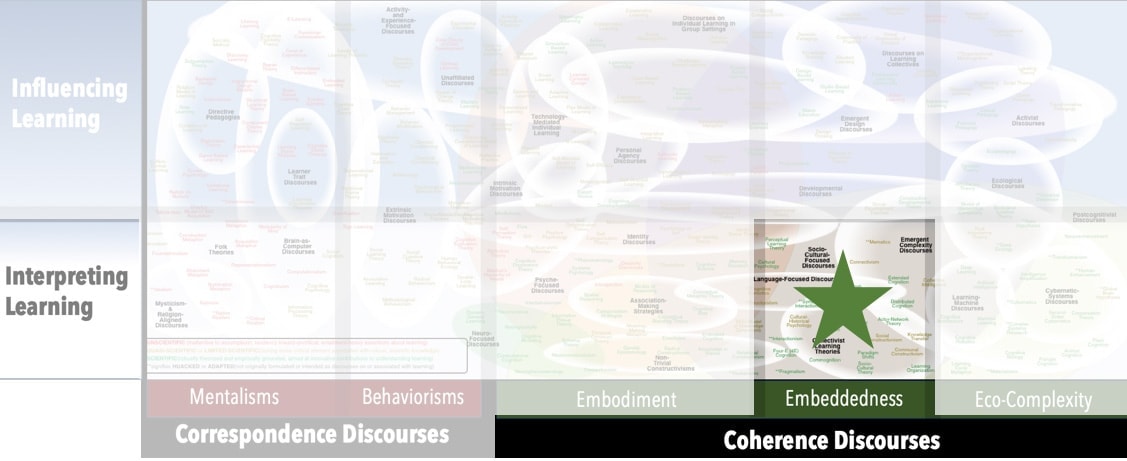AKA
Activity Systems Theory
Focus
Individual cognition and collective dynamics, involving at least two interacting “activity systems” (object-oriented, collective, socially situated, and culturally mediated human activity)Principal Metaphors
- Knowledge/knowing is … the range of possibility (within an activity system)
- Knowing is … acting (within an activity system)
- Learner is … a dynamic system (individual, collective, or culture)
- Learning is … expanding possibilities (through collective activities that are purposefully conducted around a common object)
- Teaching is … modeling, coaching
Originated
1980sSynopsis
Cultural-Historical Activity Theory (CHAT) describes how human activity is shaped by the complex web of participants and their systemic constraints. That is, CHAT explores the relationship between mind and activity, oriented by the Socio-Cultural Theory insight that one’s consciousness is shaped by social experience and mediated by artefacts. Originating with Vygotsky’s “Subject, Object, & Mediating Artefact“ triad“ (“First Generation,“ in the above illustration), humans are seen to learn by doing, and community and situation are seen as central to all forms of learning. This perspective was elaborated in Activity Theory to include consideration of how activity is mediated by social groups (“Second Generation,” illustrated above to include structures and dynamics of the collective). That perspective, in turn, is elaborated in Cultural-Historical Activity Theory to take into account multiple activity systems (“Third Generation,” illustrated above by Engeström’s model), highlighted that communities exist in relationship with other communities, each having multiple points of view, complex histories, and diverse agendas. Associated discourses include:
Originating with Vygotsky’s “Subject, Object, & Mediating Artefact“ triad“ (“First Generation,“ in the above illustration), humans are seen to learn by doing, and community and situation are seen as central to all forms of learning. This perspective was elaborated in Activity Theory to include consideration of how activity is mediated by social groups (“Second Generation,” illustrated above to include structures and dynamics of the collective). That perspective, in turn, is elaborated in Cultural-Historical Activity Theory to take into account multiple activity systems (“Third Generation,” illustrated above by Engeström’s model), highlighted that communities exist in relationship with other communities, each having multiple points of view, complex histories, and diverse agendas. Associated discourses include:
- Activity Systems Analysis (Yrjö Engeström, 1980s) – a CHAT-informed approach to stydying, interpreting, and affecting human activity in natural settings
- Change Laboratory (Finnish Development Workshop, 1990s) – a CHAT-informed, team-based approach to collaborating across organizations. Its seven-step process involves: (1) questioning, (s) analyzing, (3) modeling, (4) examining, (5) implementing, (6) reflecting, and (7) consolidating.
Commentary
Cultural-Historical Activity Theory responds to a prominent criticism of Activity Theory – namely that a focus on single activity systems is narrow and limiting – especially in the face of significant ecological issues that fall outside the purview of the theory. Taking into account multiple systems is seen as a step in the right direction, but perhaps still falling short, especially in an era when massive connectivity among many activity systems is possible. (A “Fourth Generation” has been proposed, but it is as yet underdeveloped.)Authors and/or Prominent Influences
L.S. Vygotsky; Aleksei N. Leont’ev; Yrjö EngeströmStatus as a Theory of Learning
Cultural-Historical Activity Theory is a theory of learning.Status as a Theory of Teaching
Cultural-Historical Activity Theory is not a theory of teaching. However, with its focus on interacting activity systems (i.e., available tools, possible work activities, social norms, etc.), it offers some immediately useful advice on formatting activities and engaging learners in educational action. CHAT also offers advice on interpreting and affecting mindsets of both individuals and groups, focusing on changes to their activity and the objects/outcomes that are indicative or reflective of their activity.Status as a Scientific Theory
Cultural–Historical Activity Theory meets the requirements of a scientific theory. Indeed, its authors (especially Yrjö Engeström) have led the way on articulating criteria by which the scientific merits of learning theories might be assessed.Subdiscourses:
-
Activity Systems Analysis -
Activity Systems Analysis (Yrjö Engeström, 1980s) – a CHAT-informed approach to stydying, interpreting, and affecting human activity in natural settings
-
Change Laboratory -
Change Laboratory (Finnish Development Workshop, 1990s) – a CHAT-informed, team-based approach to collaborating across organizations. Its seven-step process involves: (1) questioning, (s) analyzing, (3) modeling, (4) examining, (5) implementing, (6) reflecting, and (7) consolidating.
Map Location

Please cite this article as:
Davis, B., & Francis, K. (2023). “Cultural-Historical Activity Theory” in Discourses on Learning in Education. https://learningdiscourses.com.
⇦ Back to Map
⇦ Back to List
